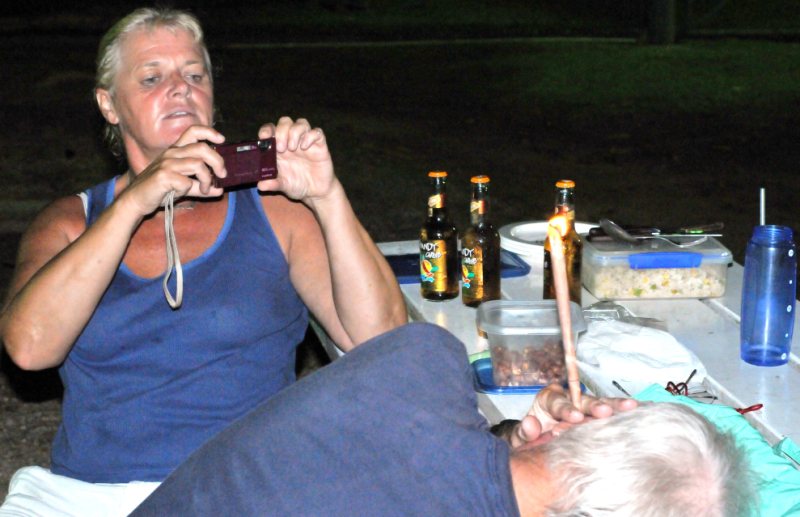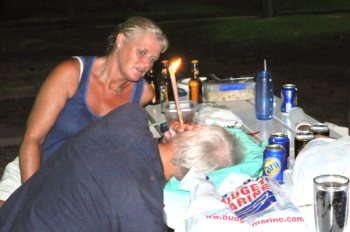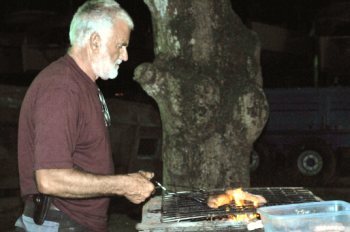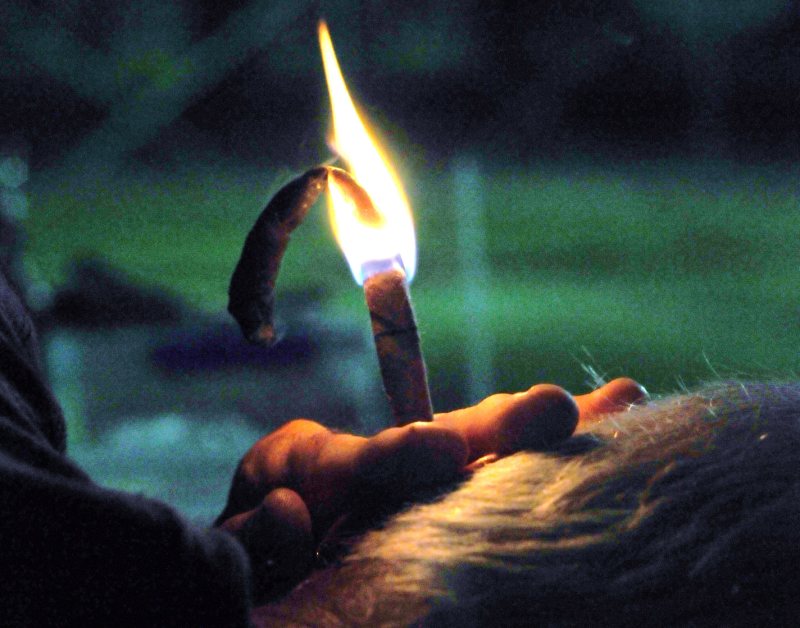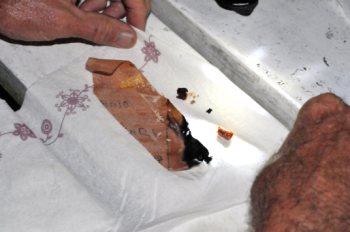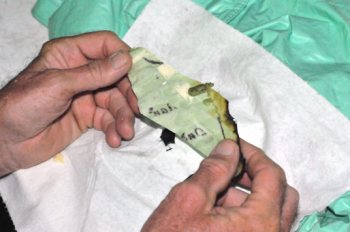Bill's Ears, Hopi Ear
Candling, Negative Waves and Hopi Indians .
Meet Bill - Against the Wind, our
American friend and guinea pig for ear candling. Sarah - Moonshiner, our candle provider, overseer and
believer in the art.
Bill loaded, ready and lit
Bear took this picture of the
lighting
Then it was time for Sarah to take a
picture of her subject
Pete - Troutbridge, seen it before,
done it and got the t-shirt. Sarah checking her
charge. Meanwhile Dick - Moonshiner gets on
with cooking at the barbecue.
Bill burns, Bear watches, Dick
cooks
At this point if all else failed - I saw it as a unique photo opportunity
Evidence unwrapped, loading the other ear
and lighting
Sarah in nurse mode, burning nicely and
new evidence. Meanwhile Dick calls that food is ready
and we get down to the serious business of eating and drinking - farewell night
for Trouters - but if his part does not arrive we could end up matching Cher's
farewell tour and do it all for the third time tomorrow night. Watch this
space.
OK so this was all new to both Bear and me, Bill felt it had
been a success and thought his hearing had improved (but he still gets stuck on
many English words that we have to translate into Merican), Sarah said he may
need to repeat the process another couple of times to remove old wax. I went
home from the tree full of questions and straight onto the net to find out what
I could. Here's a little of what I found.
Hopi Ear Candling, or Thermo Auricular
Therapy as it is also known, can be used to treat many conditions of the
ear, nose and throat area. The candles work by vapourising their ingredients
once lit, causing convectional air flow towards the first chamber of the ear.
The candle creates a mild suction which lets the vapours gently massage the
eardrum and auditory canal. Once the candle is placed in the ear it forms a seal
which enables wax and other impurities to be drawn out of the ear. There is
evidence of ear candling from all over the world, from Siberia, Asia and the
native communities of North and South America. It is the Hopi Indians of
north-east Arizona that lend their name to the treatment. They used candles in
medicinal ceremonies and initiations to clear negative energies from the head
and aura. The candles can be used today as a relaxing treatment to ease away the
stresses of our Western culture and to address a number of problems relating to
the ear, neck and face areas. Biosun candles are one of the only EU
standard candles on the market. They are specially designed with a safety filter
and a red line marked on them to designate the maximum burn level. Biosun
candles are made from linen, pure beeswax, honey extract, and essential oil of
St John's wort, chamomile and sage. You can find these candles on ebay, some
health food shops etc. Prices range from £4 - £6 a pair depending how many you
buy.
What can be treated with Hopi Ear Candles?
Tinitus, compacted ear wax and glue ear. Sore throats and hay fever.
Headache and migraine. Sinusitis and rhinitis. Catarrh and asthma. Vertigo.
Menier's Disease. Neuralgia.
What cannot be treated with Hopi Ear Candles?
Perforation or lack of eardrum. Ventilation tubes, auricular drains or
grommets. Recent ear surgery. Auricular cysts. Acute mastoiditis. Otosclerosis
or Otospongiosis. Ear tumour. If you are in doubt about any of these conditions
or problems you have with your ear you must consult your GP before attending a
treatment.
What does the treatment include?
A short consultation about medications and ear conditions. An
ear examination. A candle is then put in the first ear and lit (this lasts
approximately 9-11 minutes). The ear is then cleaned. The second ear is then
treated and cleaned. There is a facial massage to improve circulation and energy
flow to the area. The client will be asked to drink a glass of water to
rehydrate. The candles can then be examined to identify. Problems with the ear
and ascertain whether further treatments are needed
Not licensed in the USA. I found this article to disprove
the above.
Why Candling Can't Work.
Since wax is sticky, the negative pressure needed to pull wax
from the canal would have to be so powerful that it would rupture the eardrum in
the process. However, candling produces no vacuum. Researchers who measured the
pressure during candling of ear models found that no negative pressure was
created. The same investigators candled eight ears and found that no ear wax was
removed and candle wax was actually deposited in some of them. The notion that
the ear canal is connected to structures beyond the eardrum is false. A review
of a good anatomy book should dispel this notion. The external ear canal, with
an intact eardrum, is not connected to the brain, the sinuses targeted by the
procedure (those above your eyes), or the Eustacean tubes (the passageways
between the internal ear and the back of the throat). While some claim that the
eardrum is porous and quickly allows impurities to pass through, this is untrue.
The "impurities" that appear in the collected wax (usually on a paper plate or
other collecting device) are nothing more than the ashes from the burnt wick and
wax of the cone itself.
Dangers Reported
Candling poses several dangers, the most serious of which involve burning
caused by the hot wax. Candle manufacturers claim that their candles will drip
only down the outside of the ear, but shamefully few direct the user to hold the
candle horizontally to prevent this. A 1996 survey of 144 ear, nose, and throat
physicians, found that 14 had seen patients who had been harmed by ear candling,
including at least 13 cases of external burns, 7 cases of ear canal obstruction
with candle wax, and 1 perforated eardrum.
A person wrote: After undergoing ear coning, I
was amazed when the remains of the cone was cut open, and revealed what appeared
to be cerumin from my ears. However, I later discovered that it was nothing more
than melted wax from the burned-down cone itself. To investigate, I used an old
insulin bottle that had had the rubber on the top. Since the rubber was gone, I
used furnace tape to complete my experiment. I placed an ear cone into the
opening at the top of the bottle which was approximately two and a half inches
long and about an inch in diameter. I then taped around the top of the bottle
and around the smaller end of the ear cone to hold it in place at the top of the
bottle. I made sure that no air could get in or out. The bottle was laid on its
side and the ear cone was set at 30 to 40 degrees. I then lit the candle at its
largest end and, snipping off burned remains, proceeded to watch it burn down to
about 4 inches from the bottle, at which time I pulled it from the bottle and
extinguished the flame. I then cut it open length-wise and observed the contents
in the cone tube. It had the appearance, color and texture of ear wax, and
looked like ear wax, and yet was not inserted into any ear whatsoever.
While the candle burned, no smoke went into the bottle or came
out of the top of the candle. So my experiment showed that the smoke would not
enter the ear at all, and the heat some people feel is actually the heat from
the flame itself. Most of the ear cone packages state that they are for
entertainment purposes only. People who claim they have healing properties are
deceiving the public.
From a person in Washington: I wish I had found this
website earlier! I too used an ear candle and had disastrous results! An hour
after candling, I developed a terrible earache and experienced hearing loss. My
eardrums and ear canals felt like they had horrible burns. I waited a week, in
hopes that the ear pain would stop and my hearing would return to normal. When
this didn't happen, I went to a see an Ear Doctor. My eardrums and canals were
extremely red, irritated and burned. Wax from the ear candle was found on one of
my eardrums and had to be scrapped and suctioned off at the doctor's office. A
very painful procedure on sensitive burnt ears! An ear infection had also set
in, requiring prescriptions drugs of a decongestant, an antibiotic and a
steroid.
Someone else wrote: I had temporary hearing
loss for several weeks due to one use of ear candles. My normal hearing is
excellent. After using the ear candles a hearing test showed that my hearing had
dropped to below normal hearing levels! After a month of treatment and a lot of
ear pain, my hearing finally returned to it's normal level. I hope that this
dangerous product is banned so that other people are not also harmed by them!
The Hopi Cultural Preservation Office is not
aware of Hopi people ever practicing "Ear Candeling." Biosun and Revital Ltd.
are misrepresenting the name "Hopi" with their products. This therapy should not
be called "Hopi Ear Candeling." The history of Ear Candeling should not refer to
being used by the Hopi Tribe. Use of this false information with reference to
Hopi should be stopped.We appreciate your efforts to stop this false
representation the United Kingdom, and we will inquire as to whether Martin
Gashweseoma gave permission for the use of his image for the promotion of ear
candles. Thank you for your interest in resolving this situation. If you have
any questions or need additional information, please contact Lee Wayne
Lomayestewa at the Hopi Cultural Preservation Office. Thank you again for your
consideration. Respectfully, Leigh J. Kuwanwisiwma, Director Hopi Cultural
Preservation Office.
All sorts of questions arise from this
evening.
Should we have watched? Should it have been entertainment and
fun? We are all adults and no-one forced Bill to participate. Would Bear try it?
Initially at the time, he said he saw no harm in "having a go". He has always
been able to see a place for alternative therapies, so long as they lie side by
side with convention and not used in preference or excluding conventional
medicine. Since reading and checking this blog (as he checks all of them before
I send), now says "I probably wouldn't until I have done more research, I
have more questions than answers". Would I try it? Watch this space.

The name Hopi is a shortened form of what
these Native American people call themselves, Hopituh Shi-nu-mu, "The Peaceful
People" or "Peaceful Little Ones". The Catholic Encyclopedia lists the name Hopi
as having been derived from "Hopita", meaning those who are "peaceful ones".
Hopi is a concept deeply rooted in the culture's religion, spirituality, and its
view of morality and ethics. The Hopi religion is anti-war . To be Hopi
is to strive toward this concept, which involves a state of total reverence and
respect for all things, to be at peace with these things, and to live in
accordance with the instructions of Maasaw, the Creator or Caretaker of
Earth. The Hopi observe their traditional ceremonies for the benefit of the
entire world. They live in northeast Arizona at the southern end of the
Black Mesa. A mesa is the name given to a small isolated flat-topped hill with
three steep sides called the 1 st Mesa, 2 nd Mesa, and the
3 rd Mesa. On the mesa (we saw Tepui or mesa in Venezuela) tops are
the Hopi villages called pueblos. The pueblo of Oraibi on the 3 rd
Mesa started in 1050, and is the oldest in North America that was lived in
continuously. They live in pueblos that are made of stone and mud and stand
several stories high. The Kivas are an underground chamber in the pueblo
home that they used to talk and have religious ceremonies in. They used the
kivas for 100 years. The center of the floor had a fire pit. You had to climb
down a ladder to get to the south end where a bench was placed for
spectators. The Hopi Indians grew food similar to the Navajo Indians. They
raised corn or maize as the basic food. The Hopi Indians based religious
ceremonies on the corn they grew. They grew 24 different kinds of corn, but the
blue and white was the most common. They also grew beans, squash, melons,
pumpkins, and fruit. The women and men each have specific jobs or duties they
perform. The women own the land and the house. They also cook and weave the
baskets. The men plant and harvest, weave cloth, and perform the ceremonies.
When a child is born they get a special blanket and a perfect ear of corn. On
the 20 th day they take the child to the mesa cliff and hold it facing
the rising sun. When the sun hits the baby is given a name. The Kachinas are
also used in the Hopi tribe. They are powerful ancestor spirits called to bring
rain to help the crops grow. There are over 300 different Kachinas. They also
made Kachina dolls to give to the girls in the tribe and to sell to tourists.
Traditionally, Kachina dolls, which are made by the maternal uncles, are given
to young uninitiated girls at the spring Bean Ceremony and Home Dance Today, the
Hopi Indians are divided into to traditional -- which preserve ancient lands and
customs, and new -- who work with outsiders. The Hopi Indians today love their
traditions, arts, and land, but also love the modern American life. Their
children go to school and they use medical centres. The Hopi live and work
outside of the reservations. Troubles with the Navajo whose reservations
surround the Hopi still continue today. Traditionally, Hopi are organized into
matrilineal clans. A Hopi bride ground corn for
three days at her future husband’s house to show she had wife skills. The groom
and his male relatives wove her wedding clothes. After they were finished, the
bride to be would walk home in one wedding outfit, and carried the other in a
container. Women were also buried in their wedding outfit so when they entered
the spirit world they would be dressed appropriately. The Hopi man would wear
several bead necklaces on his wedding day. The Hopi area according to the 2000 Census has a population of 6,946 people.
The Hopi have been village dwellers for many
centuries (nine villages existed at the arrival of the Spanish —Sikyatki,
Koechaptevela, Kisakovi, Sichomovi, Mishongnovi, Shipaulovi, Shungopavi, Oraibi
and Awatovi).

ALL IN ALL A NIGHT QUITE DIFFERENT FROM ANY
OTHER.
| 





